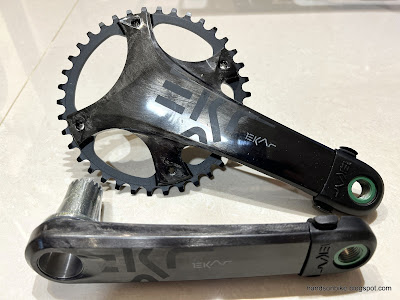Next component on the list is the Campagnolo Ekar crankset. Initially I thought of using another crankset, but I realized that I might have a problem finding a suitable chain ring. Due to the unique 13 speed chain which is extra narrow, a special chain ring is needed. Obviously the Ekar crankset and chain ring will fit, but third party options are limited.
During my research, it was not clear if there are suitable third party chain rings that will fit the Ekar 13 speed chain. In order to avoid any potential compatibility issue, I decided to use the Ekar crankset and chain ring to ensure 100% compatibility.
Campagnolo Ekar crankset designed for the 1x13 speed Ekar drivetrain. This set has 170 mm crank arm length and a 38T chain ring.
I would have preferred a smaller 36T or 34T chain ring to match the 9-42T cassette, but it is not available. In this case, a 38T chain ring with the 9-42T cassette on a 700C gravel wheelset gives a gear range of about 25" to 118", which is quite high for gravel riding.
Carbon Ekar crankset! Crank arms look good, with a very simple looking chain ring.
Ekar logo laser marked and pad printed on the crankarm which has a raw carbon finish.
Nice to see that this crankset comes with rubber boots to protect the end of the carbon crank arms.
Rubber boots are secured to the ends just with a rubber band. Crude but effective.
Rubber boots can be removed easily, as long as the pedals are not installed yet.
Narrow wide chain ring teeth. From this I can see that 38T is probably the minimum chain ring size possible, without interfering with the 4 arms of the crankset.
Due to the narrow 13 speed chain, even the wide teeth are just 3.15 mm wide.
The narrow teeth are thin and sharp at just 1.5 mm.
Compared to the SRAM 12 speed and Shimano 11 speed chain rings, the teeth on the 13 speed Ekar chain ring are even thinner. As of that time (August 2022), I don't know of any third party chain ring that is specifically compatible to the Ekar 13 speed chain.
The bottom bracket bearings come fitted on the spindle, instead of inside the bottom bracket adapters.
Another unusual aspect of Campagnolo cranksets is the spindle and bottom bracket design. The bearings are press fitted onto the spindle, instead of inside the bottom bracket adapters like every other brand. This also means that you need to use a Campagnolo bottom bracket to fit Campagnolo cranksets.
There is a large bolt that is used to join the two halves of the spindle together. It requires a massive amount of torque, with a range of 42 - 60 N.m.
As the crank bolt is located deep inside the spindle, a standard Size 10 Allen key will not be able to tighten the crank bolt to the required torque. A special tool is needed to reach inside the spindle in order to fix the crank bolt properly.
Here is the bolt that will be used to join the two halves of the spindle.
Each end of the spindle makes up a Hirth joint, which is a self centering and self aligning joint. Campagnolo claims that this construction allows a wider bearing stance and a flatter crank profile around the spindle.
Splitting the spindle into two halves means that it may be harder to control the cylindricity of the spindle when joined, as compared to having a one piece spindle.
Right crankarm with half a spindle, chain ring, fixing bolt and bearings weigh 389 grams.
Left crank arm with half a spindle and bearings weigh 229 grams.
In total, this carbon Ekar crankset weighs 618 grams, including the bearings and rubber boots. If we add the Campagnolo bottom bracket (without bearings, 57 grams), this total crankset + bottom bracket set would weigh 675 grams.
For comparison, a Dura-Ace R9100 crankset (610 grams) with Dura-Ace BB-R9100 (66 grams) would weigh almost the same at 676 grams. Given that the Dura-Ace crankset has a double chain ring, and uses aluminium crank arms, the Ekar carbon crankset should actually be much lighter.
In other words, even though the Campagnolo Ekar crankset is made of carbon, it is not actually lighter than a high quality aluminium crankset. There are lighter carbon crankset options available in the market.
Here is how it a Hirth joint looks like.
Hirth joint in the middle, and bottom bracket bearings press fitted onto the spindle at both ends. Only Campagnolo uses this construction to make a crankset.
Once again, we see the unique construction used by Campagnolo to design the crankset, especially at the spindle area.
Technically speaking, the Campagnolo method of press fitting the bearing to the spindle is of sound engineering design, as the recommendation is for the rotating part (spindle) to be press fitted to the bearing to avoid any slippage.
However, practically every other bottom bracket and crankset manufacturer has the bearings press fitted to the fixed part (bottom bracket adapter) instead. This is for ease of assembly and replacement, as the bottom bracket can be replaced easily along with the bearings.
The next post will show the special Campagnolo bottom bracket and the super narrow Ekar 13 speed chain.



















You are comparing the weight of a gravel groupset against a road group set. Why?
ReplyDeletebecause the carbon Ekar crankset weighs more than an aluminum crankset, which doesn't make sense. Why use carbon to make the crankset when it is going to be heavier and more expensive.
DeleteAgree that the build specifics for a gravel crank versus a road crank is like a weight comparison of apples to oranges. It makes more sense if you compare the Ekar crank weight to other gravel cranks.
ReplyDelete